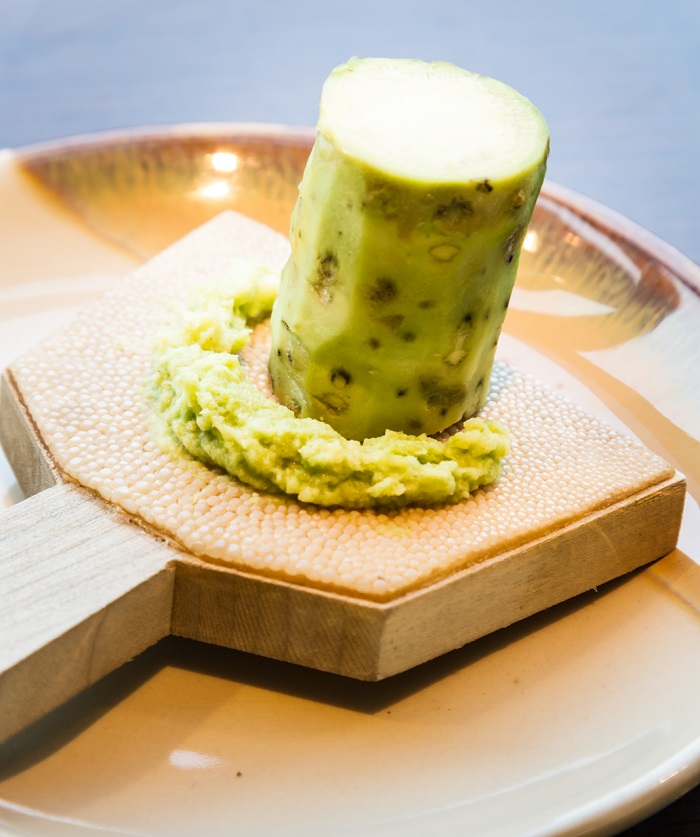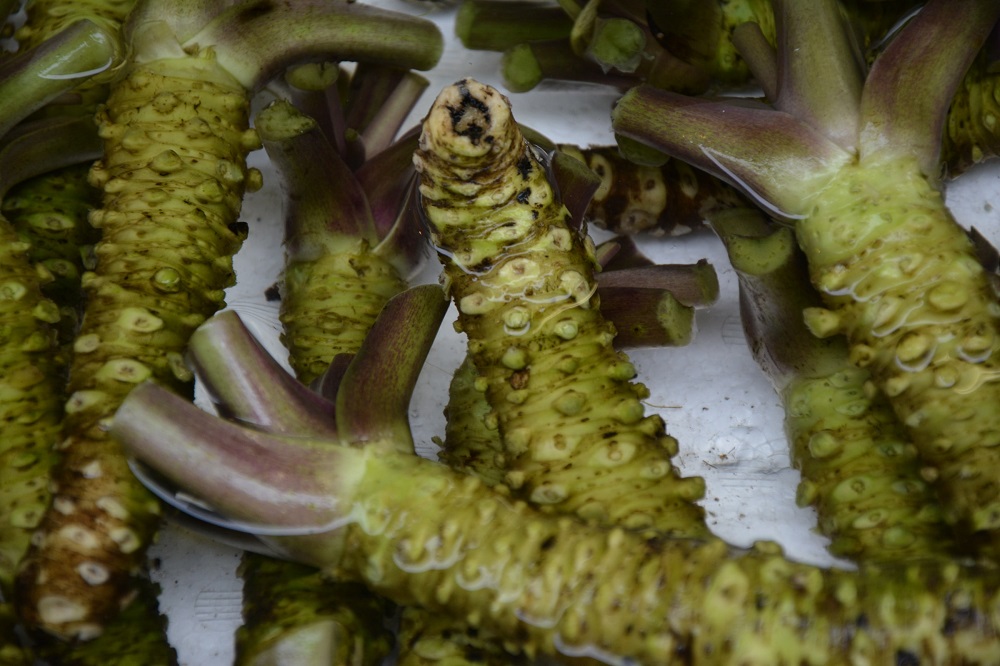If you’ve ever had sushi, then there’s a good chance you’ve also tried a spicy green “Wasabi” paste that usually accompanies sushi. However, over 90% of wasabi served in sushi restaurants does not contain any real wasabi! How is Wasabi made? How to differentiate between real and fake wasabi? How to make your own Wasabi paste at home? This blog post is going to be a comprehensive guide to Wasabi.
What is Wasabi?
Wasabi, also known as Eutrema Japonicum or Wasabia Japonica, is a type of Japanese spice that is most commonly used as a condiment to sushi. It can be used to add flavor to any recipe, like these Wasabi Beef Fajitas.
Wasabi is a type of Japanese horseradish that is made from the rhizome of the Wasabia japonica plant. The signature clean spiciness of wasabi comes from allyl isothiocyanate, which is why it sometimes feels like you’re “going up your nose” when you take a bite.
What does Wasabi Taste Like?
Wasabi is a type of Japanese horseradish that is used as a condiment for sushi. It has a very strong flavor, and it is meant to highlight the flavor of the fish that it is served with. It has a pungent, yet delicate flavor that highlights the flavor of raw fish. The heat provided by wasabi served with sushi is meant to highlight the fish’s flavor, not cover it up. Sushi chefs use wasabi to balance the flavor of fish in nigiri sushi.
Fake “wasabi” is made from horseradish and sometimes mustard, which makes it hotter and last longer than authentic wasabi. Too much of this imitation wasabi will overpower the taste of sushi.
How much wasabi shall you use? Instead of adding wasabi to your soy sauce, you can either take a bite of your sushi and then add a blob of wasabi on one side, or if needed, you can dip the other side in soy sauce and eat.
If you’re a beginner, be sure to avoid contact with the wasabi in your mouth – this may cause discomfort. Chefs usually add wasabi to sushi at an amount that is tolerable for beginners.
Why is Wasabi so Spicy?
The chemical compound allyl isothiocyanate in wasabi is what gives it its spiciness. Wasabi root is grated very finely and then the allyl isothiocyanate is released, making the wasabi spicy! Whereas chili peppers type of spice hit the tongue directly, wasabi’s spiciness is felt primarily through the nose.
How is Wasabi Made?
Wasabi is a type of hot pepper that is part of the Brassicaceae family. Other plants in this family include horseradish, radishes, and mustard, which all have a similar hot flavor to wasabi.
Most wasabi found in grocery store and with prepackaged sushi is not authentic because it is made of powdered horseradish and artificial color, and may also contain mustard powder and thickening agents like flour.

How do You Differentiate Between Real and Fake Wasabi?
Most sushi served in restaurants does not contain any real wasabi. This is because most wasabi is made from a mixture of horseradish powder and mustard seeds. The texture of fake wasabi is often pasty and thick, while real thing will have a grated, gritty texture.
To get the most intense flavor from wasabi, it is shall served freshly grated.
The traditional and best way to grate wasabi is to run the root in circles over a sharkskin grater, which acts like sandpaper, shaving very fine pieces of wasabi off of the root.
If the wasabi paste has a smooth texture, it is likely fake wasabi. If the green paste has a gritty texture, it is most likely real deal from a wasabi plant stem.
Real wasabi is often used in sushi, as it enhances the flavor of fish and other ingredients. Because it loses its potency quickly once grated, true wasabi is usually served fresh at high-end Japanese restaurants where chefs carefully grate just the right amount to complement the dish and preserve its flavor.
Real wasabi paste is made from the wasabi rhizome, which is a subterranean stem of the plant. When you grate it, the volatile compounds that give it its distinguished taste start to break down within minutes. That’s why real wasabi paste has better taste when it’s really fresh. The fake wasabi paste is cheaper and has a longer expiration date than the real wasabi.
Wasabi comes in three forms: paste, powder form, and the Wasabi rhizome. The wasabi paste in squeeze tube should be frozen and shipped frozen. Keep the remainder in the fridge once you start using it. It’s definitely not as good as fresh wasabi. Wasabi powder is less expensive than the paste variety, but also less good.
If you’re looking for a Wasabi rhizome that you have to grate yourself with a grater, preferably a shark skin paddle, then be sure to check out online stores. These days there are several places where you can find this type of wasabi. Some specialized Asian markets that carry rare foods may have real wasabi and most likely offer it as the root of the plant, rather than in a container. Make sure to keep it hydrated in the fridge and it should last for about a month.

Brief History of Wasabi
Wasabia japonica is a medicinal plant that has been used for thousands of years, after it was first discovered growing next to mountain streams in Japan. Honzo Wamyo, Japan’s oldest encyclopedia of medicinal plants, includes the word “wasabi” among its entries.
The wasabi plant is native to Japan and is thought to have been first used as a seasoning for sushi during the Bunka/Bunsei era of the Edo period.
Today, commercial enterprises farm wasabi rhizomes in mountain environs in Shizuoka prefecture on Izu peninsula and in the Azumino plains of Nagano prefecture. Shizuoka Prefecture is located in the center of Japan and is bordered by Nagano Prefecture to the north, Aichi Prefecture to the east, and Yamanashi Prefecture to the south.
Incredible Benefits of Real Wasabi
Wasabi is a type of Japanese horseradish that has been used as a spicy condiment for centuries. Not only does real wasabi taste better, it has been shown to have health benefits, including reducing inflammation and promoting healthy digestion.
The rhizome of this plant contains a good amount of minerals, including potassium, manganese, iron, copper, calcium (128 mg/100 g), and magnesium. It also has average levels of essential vitamins such as folate (5 μg/g), vitamin B-6 (pyridoxine), vitamin C, riboflavin, niacin, and pantothenic acid.
Hon-wasabi is a delicious and healthy addition to sushi. It has many vitamins and antioxidants, which offer a range of health benefits. Wasabi is a root vegetable that contains the main class of active compounds called isothiocyanates (ITCs), which give it its range of health benefits, including antibacterial and anti-inflammatory properties.
Wasabi can help improve the immune system and remove harmful toxins, which can even kill harmful food-borne bacteria.
Wasabi has many health benefits, including boosting the immune system, improving gut health, helping with arthritis and bone-related issues, reducing the risk of cancer, reducing the risk of heart disease and protecting heart health, having anti-inflammatory properties for joints and muscles, antibacterial properties & can kill food-borne bacteria , healing respiratory conditions , promoting fat loss.
Wasabi might have health benefits, but remember that it comes with a high price tag.
Hon wasabi is a high-quality, authentic-flavored wasabi that can be found only in Japan. The commercially prepared wasabi typically comes in three grades: those with 100% real wasabi, those with only 25% real wasabi, and those containing no actual real wasabi. 25% and 0% of wasabi products are usually mixed with other ingredients such as horseradish, mustard, and cornstarch and green food coloring.
Many experts believe that wasabi is the most difficult plant to grow commercially. Wasabia Japonica grows under specific conditions, and it is sensitive to environmental changes. Hence, real Wasabi fetches a high price at the market.
Most wasabi is cultivated in Japan, although a handful of farms have been established in North America. The high demand for wasabi rhizomes has led to the cultivation of a few farms for this hardest plant in North America. In the United States, you won’t find real wasabi at most restaurants or grocery stores, as it costs more than $110 per pound.
Frequently Asked Questions About How is Wasabi Made
How is Real Wasabi Made?
To make wasabi like a pro, start by running the real wasabi root over sharkskin wasabi grater which acts like sandpaper. Shearing very fine pieces of wasabi from the root will create a smoother paste. If the paste has a gritty texture, it is most likely real wasabi from a wasabi plant stem.
Real wasabi is often used in sushi, as it enhances the flavor of fish and other ingredients. Because it loses its potency quickly once grated, real wasabi is usually served fresh at high-end sushi restaurants where chefs carefully grate just the right amount to complement the dish and preserve its flavor.
The fake wasabi paste is cheaper and has a long shelf life than the real stuff.
How Wasabi is Made in Japan?
Japanese horseradish, scientifically known as Wasabia japonica or Eutrema japonica, is a root that grows in Japan. Fresh wasabi paste can be made by grating ground rhizomes ( underground stem of the wasabi plant) using a sharkskin grater. The finer the grate, the more intense the flavor will be.
Why is Real Wasabi so Rare?
Wasabi plants require specific conditions to grow and thrive: constant running spring water, shade, rocky soil, and temperatures between 46-68 degrees Fahrenheit year-round. Real wasabi is difficult to cultivate and therefore rare. This makes it expensive, which means that most people eat horseradish (in Japanese is called the Western Wasabi) instead of the real thing.
What is Japanese Salad Dressing Made of?
One of the most popular Japanese-style salad dressings is called “Wafu.” It’s similar to a vinaigrette and comes in many different variations, but always contains soy sauce, rice wine vinegar, and sugar.
How much does real wasabi cost?
Fresh wasabi is rare to come across and can cost around $110 per pound. The wasabi you’re used to eating is probably just horseradish, sweetener, and food coloring.
How to Make Homemade Wasabi?
It’s easy to make a homemade wasabi paste.
To make fresh wasabi paste, grate the wasabi rhizome using a sharkskin grater. The finer the grate, the more intense the flavor will be. Ingredients that you need are 1 piece fresh wasabi rhizome and about half teaspoons of cold water.
Wash the wasabi rhizome under cool running water. Trim any bumps and cut a segment for the amount you wish to use. With thick end of wasabi held perpendicular to grater, press tightly and use small circular motion to grate wasabi. Once grated, press on paste to further release flavors and maximize taste. Gather paste in ball form.
Only prepare as much wasabi paste as you plan to use. The paste will lose its flavor after about half an hour.


